
Spione is a 1928 German silent espionage thriller directed by Fritz Lang and co-written with his wife, Thea von Harbou, who also wrote a novel of the same name, published a year later. The film was Lang's penultimate silent film and the first for his own production company; Fritz Lang-Film GmbH. As in Lang's Mabuse films, Dr. Mabuse: The Gambler (1922) and The Testament of Dr. Mabuse (1933), Rudolf Klein-Rogge plays a master criminal aiming for world domination.

Friedrich Rudolf Klein, better known as Rudolf Klein-Rogge, was a German film actor, best known for playing sinister figures in films in the 1920s and 1930s as well as being a mainstay in director Fritz Lang's Weimar-era films. He is probably best known in popular culture, particularly to English-speaking audiences, for playing the archetypal mad scientist role of C. A. Rotwang in Lang's Metropolis and as the criminal genius Doctor Mabuse. Klein-Rogge also appeared in several important French films in the late 1920s and early 1930s.
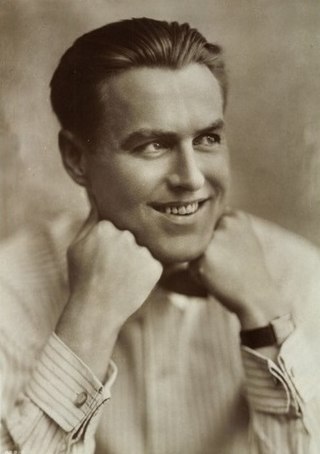
Paul Richter was an Austrian film actor. He owed his great popularity in German films of the silent era largely to the directors Joe May and Fritz Lang.

Peter the Pirate, also known in English as The Sea Wolves, is a 1925 German silent historical adventure film directed by Arthur Robison and starring Paul Richter, Aud Egede-Nissen, and Rudolf Klein-Rogge. It was based on the 1925 novel by Wilhelm Hegeler. Leni Riefenstahl was offered the role of female lead by producer Erich Pommer, but after doing a screen test she turned it down.
The White God is a 1932 Danish-German adventure film directed by George Schnéevoigt and starring Paul Richter, Mona Mårtenson, and Rudolf Klein-Rogge. It premiered on 14 May 1932.
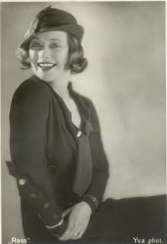
Ursula Grabley was a German actress. She appeared in more than 80 films and television shows between 1929 and 1977. Her acting career started during the late silent era and blossomed in the sound era that soon followed. The cast of the 1929 silent film Katharina Knie included Ursula and her then husband Viktor de Kowa.
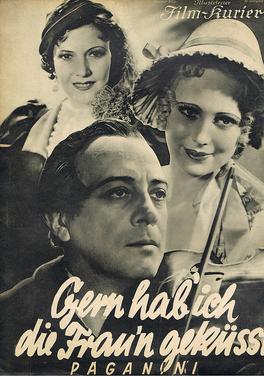
Paganini or I Liked Kissing Women is a 1934 German operetta film directed by E. W. Emo and starring Iván Petrovich, Eliza Illiard, and Theo Lingen. It is an adaptation of Franz Lehár's 1925 operetta Paganini.

Bashful Felix or Felix is Right on Target is a 1934 German comedy film directed by Carl Boese and starring Rudolf Platte, Ursula Grabley, and Jakob Tiedtke. It was made by Terra Film, with sets designed by art directors Robert A. Dietrich and Bruno Lutz.
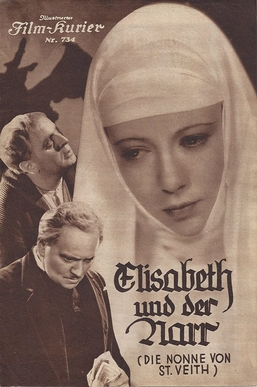
Elisabeth and the Fool is a 1934 German drama film directed by Thea von Harbou and starring Hertha Thiele, Theodor Loos and Rudolf Klein-Rogge. The film was the directing debut of Harbou, who was known for her screenplays for directors such as Fritz Lang and F. W. Murnau. Filming began on 12 October 1933 in Meersburg and the Lake Constance area. The film's sets were designed by the art directors Kurt Dürnhöfer and Walter Reimann. The film premiered on 24 January 1934.
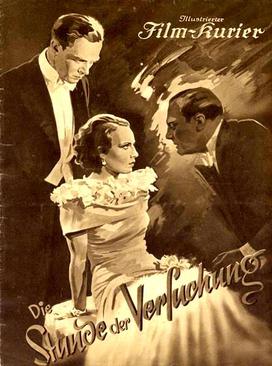
The Hour of Temptation is a 1936 German mystery film directed by Paul Wegener and starring Gustav Fröhlich, Lída Baarová and Harald Paulsen.

A Strange Guest is a 1936 German drama film directed by Gerhard Lamprecht and starring Alfred Abel, Ilse Petri and Kurt Fischer-Fehling.

The Golden Anchor is a 1932 German-French drama film directed by Alexander Korda and starring Albert Bassermann, Ursula Grabley, and Mathias Wieman. It is the German-language version of Marius (1931), based on Marcel Pagnol's 1929 play of the same title and the first part of his Marseilles trilogy. Such multi-language versions were common during the early years of sound. It was made at the Joinville Studios by the European branch of Paramount Pictures.

Marriage Strike or Matrimonial Strike is a 1935 German comedy film directed by Georg Jacoby and starring Trude Marlen, Paul Richter and Erika von Thellmann. It was remade in 1953.

Men Are That Way is a 1939 German drama film directed by Arthur Maria Rabenalt and starring Hertha Feiler, Hans Söhnker and Hans Olden. The film's sets were designed by the art director Willi Herrmann. It was remade by Rabenalt in Austria as Arena of Fear (1959).

The Judas of Tyrol is a 1933 German historical drama film directed by Franz Osten and starring Fritz Rasp, Camilla Spira, and Marianne Hoppe. It was shot at the Johannisthal Studios in Berlin. The film's sets were designed by the art director Hans Jacoby. Its Berlin premiere was at the Marmorhaus.

Circus of Life is a 1921 German silent drama film directed by Johannes Guter and starring Werner Krauss, Lydia Potechina and Rudolf Klein-Rogge.

Mamitschka is a 1955 West German comedy-drama film directed by Rolf Thiele and starring Mila Kopp, Rudolf Platte and Jester Naefe.

Between Heaven and Earth is a 1934 German historical drama film directed by Franz Seitz and starring Rudolf Klein-Rogge, Heinz Klingenberg, Attila Hörbiger and Karin Hardt. It was shot at the Bavaria Studios in Munich. The film's sets were designed by the art director Max Seefelder. It is based on the 1856 novel of the same title by Otto Ludwig which was subsequently remade as a 1942 film.

Stars of Variety is a 1939 German-Hungarian drama film directed by Josef von Báky and starring La Jana, Christl Mardayn and Karin Hardt. It was shot at the Hunnia Studios in Budapest. The film's sets were designed by the art directors Robert A. Dietrich and Artur Günther. Separate German and Hungarian-language versions were produced.


















